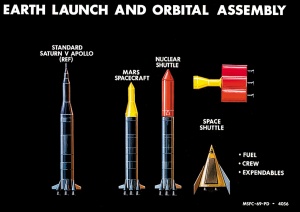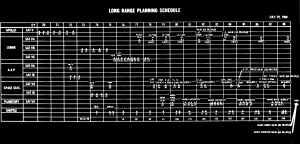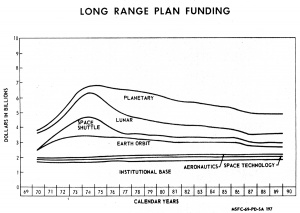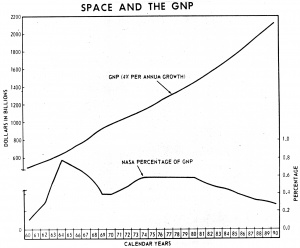Manned Mars Landing by Wernher von Braun Pt 5
From The Space Library
Contents |
EARTH LAUNCH AND ORBITAL ASSEMBLY
The Mars spacecraft and the Nuclear Shuttles will be launched into Earth orbit using two stage Saturn V's. The Mars mission crews, expendables (food, water, etc.) and a portion of the fuel for the Nuclear Shuttles are carried to orbit with Space Shuttles.
Earth Launch and Orbital Assembly
Nuclear Shuttles for the maneuvers at Mars and for Earth return (the center shuttle) will be launched from Earth surface, with approximately one half of its propellant on board. The remaining fuel will be provided via Space Shuttle flights.
It is envisioned that Nuclear Shuttles already in orbit for other uses can be employed for the Earth escape maneuver (the outer shuttles). Fuel for these shuttles will also be provided from Earth surface via Space Shuttle flights.
The Mars spacecraft would be assembled and checked out on the ground prior to (unmanned) launch.
Then after orbital assembly, checkout, and crew boarding, the vehicles are ready for departure.
LONG RANGE PLANNING SCHEDULE
The manned Mars landing mission that has been presented is but one mission in a total space program. It is desirable at this time to consider this mission in context of the total program. This is shown on the facing page. Missions depicted for the decade of the 1970's are taken from the Integrated Space Program presented recently to the Space Task Group. These missions have been extrapolated into the 1980's in order to give a continuous program which could be used in determining funding requirements for the 1970 80 time period. The rationale for the extrapolation was to project an aggressive manned program in all areas utilizing the systems developed in the 1970's. Annual funding requirements for this program are shown on the following chart.
Long Range Planning Schedule
LONG RANGE PLAN FUNDING
This funding shown in 1969 dollars reflects major emphasis in the mid 1970's on an expanding Earth orbital and lunar program. By 1980 the planetary program becomes prominent in the funding requirements while the lunar and Earth orbital funding remain essentially constant.
Major Earth orbital cost items include development of the common mission module, space shuttle, earth orbital experiments, and the operational costs associated with these items. The lunar costs include funds for development and operation of the nuclear shuttle, space tug, common mission module modifications for lunar surface, and accompanying lunar experiment costs.
Long Range Plan Funding
The planetary costs include funds for development and operation of the Mars excursion module and planetary experiments plus the operation of the nuclear stage, mission module, launch vehicles and unmanned payloads.
An institutional NASA base approximately equal to that which exists today is included in the funding. Additionally, funds for continuing technical efforts in the areas of aeronautics and space technology are shown.
SPACE AND THE GNP
The accompanying curves indicate the Gross National Product and the NASA budget plotted as a percentage of this GNP for a 30 year span from 1960 to 1990. The GNP line reflects actual data through mid 1969 and is increased by 4% per annum thereafter. This is a projected "real" growth rate without inflation.
The NASA percentage of the GNP reached a peak of 4/5 of 1% in 1964. It has dropped steadily since then to approximately 2/5 of 1% at present. The projected space program funding requirements would cause this value to increase to 3/5 of 1% in 1974 and decline slowly throughout the remaining years. By 1990, the NASA budget would only equal 1/5 of 1% of the GNP.
Space and the GNP




